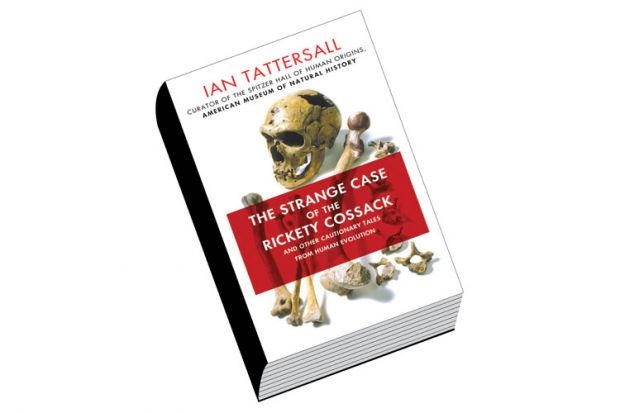Although the title conjures up images of a Sherlock Holmes mystery set in a gastropub, it is with a tinge of regret that I must report that this book does not feature Holmes and Watson tackling the problem of the £20 burger, or Sherlock being forced to stand out in the rain to smoke his pipe. Pleasingly, however, what we do have is one of the most engaging and thought-provoking books on human evolution of recent times. Rather than offering (yet another) narrative account of the subject, Ian Tattersall critically engages with its intellectual history. The result is a compelling exploration of not just how human evolution has developed, but also an insider’s account of how the personalities involved have shaped and driven the research agenda of the past 150 years.
Perhaps one of the most striking things about the development of the study of human evolution is the proprietorial interest everyone has in it. From the most ardent Darwinist to the most strident (and deluded) creationist, the fossils, material remains and latest ideas generated by researchers attract much greater public attention than almost any other branch of the sciences. As much as we in the trade might dislike the inevitable caricature of the caveman (with or without attendant dinosaurs), there is no denying the PR benefits of being able to represent a whole subject with a simple image. This has not developed by chance, and popular interest in the subject is one of the key areas Tattersall explores.
So what does the book’s title mean? It harks back to the controversy that surrounded the analysis of what would become the first recognised Neanderthal remains. (Two other sets had previously been found in Gibraltar and Belgium, but were not recognised as Neanderthal until much later.) After their discovery during quarrying in Germany’s Neander Valley in 1856, a fossilised skullcap and other bones were examined by, among others, the anatomist Franz Mayer. He decreed that the remains belonged to a Cossack soldier who had suffered from rickets and developed pronounced ridges above his eye sockets from furrowing his brow in pain. Worse luck, he had managed to get himself buried under nearly 2m of fossil-bearing cave deposits.
It is from this early misdiagnosis that the image of the knuckle-dragging and stooping, not to mention stoo-pid, Neanderthal began to capture the popular imagination, and the “Rickety Cossack” was born. German science was globally pre-eminent during much of the 19th century, and the public obligingly treated its experts’ views as statements of fact rather than working hypotheses. But the publication of Charles Darwin’s On the Origin of Species in 1859 produced a seismic shift in thinking and provided the foundation for scientists such as Thomas Huxley to argue that the Neanderthals were prehistoric humans.
What this illustrates is the wide gulf that existed (and to some extent still exists) between the discovery and the interpretation of fossils in human evolution. Views on the subject can be divided into two broad camps – “lumpers” and “splitters” – and if you think this is starting to sound a little Monty Pythonesque, you’re not too wide of the mark. Lumpers argue for the placing of all fossils in a small group of species, while splitters argue for a large number of species based on small degrees of difference. While both camps have their extremists, most researchers can be found somewhere in the middle.
The development of ideas about how evolution shaped the adaptations of the hominins is shown via the move from thinking of human evolution as a single branch (where one species evolves into the next and so on) to viewing it as a much more complex group of interrelated species, many of whom coexisted. Once again we find ourselves in the world of lumping and splitting, even as we are forced to consider the uniqueness of humans when compared with other species. For much of the history of human evolutionary thought, it was orthodoxy that humans were special, occupying a unique place in nature. Consequently, our evolution must have been special and somehow different (for different one could generally read better) than other organisms. What we now take as orthodoxy, especially as our understanding of ancient DNA improves, is that while humans do many things that no other species do, we are no more or less evolved than any other creature. Instead, we are a product of the selective pressures that we have undergone over the past 7 million years. To put it another way, humans would make lousy louses, and vice versa.
What Tattersall deftly highlights is how internal disagreements on what the fossils represent has often created a chaotic background on which to try to paint our pictures. From the discovery of the Rickety Cossack in 1856 until well after the Second World War, it was more or less standard practice for every new fossil discovery to be given its own species name. This was because there was a relatively poor understanding of the big picture of hominin evolution and diversity. (And, more prosaically, because people like naming new species – it’s cool.)
Perhaps nothing reflects this better than the “discovery”, in a gravel deposit in Sussex in 1912, of remains that would be dubbed “Piltdown Man”. The mysterious skull combined a mixture of a primitive jaw and face with a big brain. As Tattersall recounts, many people in the UK – scientists as well as the public, it must be noted – allowed themselves to be convinced that this “fossil” demonstrated that big brains were a European adaptation, broadly confirming popular (albeit erroneous) concepts of racial superiority.
Two further things are worthy of note. First, outside the UK, Piltdown Man was always seen as highly suspect (it was in fact an orang-utan’s facial bones crudely dyed and stuck on a human skull vault). Second, a stone cricket bat was found with the skull. Put simply, Piltdown was a joke, almost certainly perpetrated by serial prankster Charles Dawson (with or without the help of a veritable Who’s Who of the Edwardian scientific Establishment, including Sir Arthur Conan Doyle). Although it was not officially unmasked as a fraud until the 1950s, it had long since become an irrelevance as the focus of research shifted to Africa. I recall a colleague, only half jokingly, blaming it for the often disapproving reaction that human evolution seems to trigger in other disciplines and for the lack of Royal Society fellows among our number.
Although the Piltdown hoax is an extreme example, it typifies the way that personalities and strongly held views can shape data to support a predetermined conclusion. As Tattersall puts it: “in the large and indispensable gray area of science – including much of palaeoanthropology – in which propositions are not directly testable by experiment or observation, researchers can easily be led astray by their preconceptions”. Of course, no human endeavour is immune to this, but the stakes seem to be higher when we are considering our origins.
Perhaps the simplest message to take away from this excellent book is that humans are odd. Indeed, it might well be asking too much of what Douglas Adams called an “ape-descended life form” who are “so amazingly primitive that they still think digital watches are a pretty neat idea” to be able to approach the science of its own evolution without hitting a few bumps along the road.
Simon Underdown is principal lecturer in biological anthropology, Oxford Brookes University.
The Strange Case of the Rickety Cossack and Other Cautionary Tales from Human Evolution
By Ian Tattersall
St Martin’s Press, 256pp, £18.99
ISBN 9781137278890 and 9781466879430 (e-book)
Published 1 August 2015
The author
 Palaeoanthropologist, author and curator Ian Tattersall was born in the UK and raised in East Africa. He read archaeology and anthropology for his undergraduate degree at the University of Cambridge, where he would also complete his master’s. He later undertook doctoral studies in geology and vertebrate palaeontology at Yale University, and completed his PhD in 1971.
Palaeoanthropologist, author and curator Ian Tattersall was born in the UK and raised in East Africa. He read archaeology and anthropology for his undergraduate degree at the University of Cambridge, where he would also complete his master’s. He later undertook doctoral studies in geology and vertebrate palaeontology at Yale University, and completed his PhD in 1971.
That same year, Tattersall took an assistant curator’s post at the American Museum of Natural History in New York City. Although he has also held a number of academic posts at institutions including Columbia University and the City University of New York, Tattersall has remained faithful to the museum for more than four decades.
Today he is curator emeritus in the museum’s division of anthropology and professor emeritus at its Richard Gilder Graduate School.
Tattersall’s fieldwork has taken him to locations as diverse and far‑flung as Madagascar, Mayotte, Comoros, Mauritius, Réunion, Borneo, Nigeria, Niger, Sudan, Yemen, Vietnam, Surinam and French Guiana, as well as to a number of sites in his adopted home of the US.
His research interests include human and non-human primate evolution, the anatomical and cognitive origin of Homo sapiens, the application of evolutionary and systematic theory to human phylogeny, and the systematics, ecology and conservation of the strepsirrhines, the group of primates that includes lemurs.
On his American Museum of Natural History web page, Tattersall says he finds it curious that he is “considered an extreme splitter in the hominid domain and an enthusiastic lumper in the lemur one, despite applying pretty consistent standards across the board”.
Karen Shook
POSTSCRIPT:
Print headline: Bones of contention
Register to continue
Why register?
- Registration is free and only takes a moment
- Once registered, you can read 3 articles a month
- Sign up for our newsletter
Subscribe
Or subscribe for unlimited access to:
- Unlimited access to news, views, insights & reviews
- Digital editions
- Digital access to THE’s university and college rankings analysis
Already registered or a current subscriber? Login
